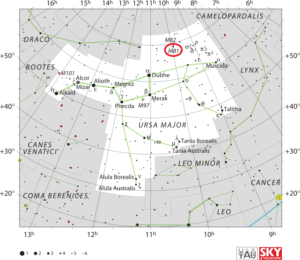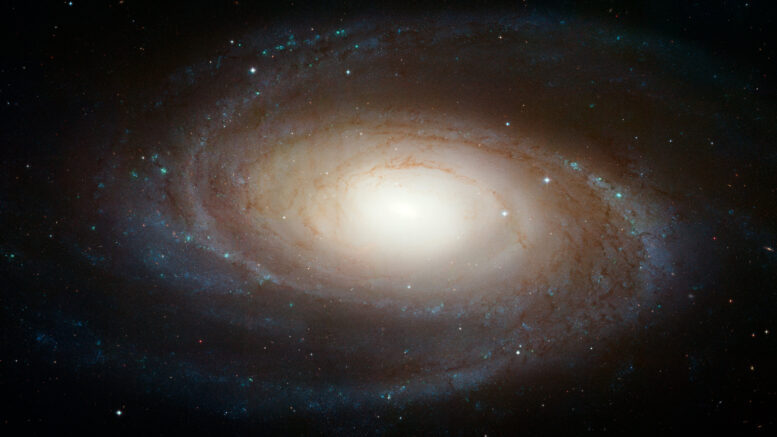Messier 81, also known as Bode’s Galaxy, is a grand design spiral galaxy located in the constellation Ursa Major. Discovered by the German astronomer Johann Elert Bode in 1774, M81 is one of the brightest galaxies in the night sky. It is located 11.6 million light-years from Earth in the constellation Ursa Major and has an apparent magnitude of 6.9. Through a pair of binoculars, the galaxy appears as a faint patch of light in the same field of view as M82. A small telescope will resolve M81’s core. The galaxy is best observed during April.
| Description | |
| Visible From Pacific Northwest | November To April |
| Best Time To Observe | April |
| Minimum Size Of Viewing Device | Binoculars |
| Object Type | Spiral Galaxy |
| Designations | Messier 81, M81, Bode’s Galaxy, NGC 3031, PGC 28630, UGC 5318, 2E 2195, 2E 0951.4+6918, IRAS 09514+6918, 2MASX J09553318+6903549, MCG+12-10-010, RBS 808, Z 333-7, Z 0951.4+6918, SDSS J095533.16+690355.1, SDSS J095533.14+690355.2, SPB 115, TC 714, RORF 0951-693 |
| Right Ascension | 09h 55m 33.2s |
| Declination | +69°03’55” |
| Constellation | Ursa Major |
| Number Of Stars | More Than 250 Billion |
| Apparent magnitude | +6.94 |
| Apparent dimensions | 26′.9 x 14′.1 |
| Object Radius | 45,000 light years |
| Distance From Earth | 11.8 million light years |
History
Pierre Méchain independently found M81 and M82 in August 1779 and reported the discovery to Charles Messier. Messier determined the positions of both objects and added them to his catalogue on February 9, 1781.
Bode’s Galaxy was named after Johann Elert Bode, the German astronomer who discovered it on December 31, 1774, along with the nearby Cigar Galaxy. He described the pair as “two small nebulae 3/4 degrees separated.”
William Herschel observed the object a number of times. After seeing it in his large 10-foot telescope on November 26, 1810, he noted, “I viewed the nebula with the large 10 feet. It has a bright, resolvable nucleus, certainly consisting either of 3 or 4 stars or something resembling them. It is about 15 or 16′ long. The object was already too low to be seen to an advantage.”
John Herschel catalogued M81 as h 649 and later added it to the General Catalogue as GC 1949. He described the object as “Remarkable; extremely bright; extremely large; extended in position angle 156.0 degrees; gradually, then suddenly very much brighter toward the middle where there is a bright nucleus.”
A supernova was observed in Bode’s Galaxy in 1993. Named SN 1993J, the supernova was first detected by the Spanish amateur astronomer Francisco Garcia Diaz on March 28 of that year. Reaching a maximum brightness of 10.5, it was the second brightest supernova event seen in the 20th century at the time of discovery.
Locating M81 In The Sky
Bode’s Galaxy can be found about 10 degrees northwest of Dubhe, Alpha Ursae Majoris. An imaginary line drawn from Phecda, Gamma Ursae Majoris to Dubhe and extended by roughly the same distance as that between the stars leads to M81.

Viewing M81
It can easily be seen in binoculars, which only show a dim patch of light, and is best viewed in larger telescopes, which reveal details of the galaxy’s spiral structure. 3-inch telescopes show M81 as a hazy, bright oval-shaped patch of light, while 6-inch telescopes reveal the galaxy’s bright core surrounded by a faint halo. The best time of year to observe M81 is during the spring.
Photographing M81
Messier 81 and Messier 82 can indeed be captured in 1 image together, even with a DSLR without a telescope. However, if this is done, one will still require autoguiding to accurately capture the image with larger exposures to get the exposure length necessary to get the details shown in the image. It is indeed possible to get these images without guidance, but that requires shorter exposures. If you want to photograph M81 and M82 using a camera and telescope, it is suggested using a focal length of at least 800mm or more. This magnification is needed to record the delicate details of each galaxy. Shorter focal lengths might see loss of detail due to the shorter focal lengths.
https://www.galactic-hunter.com/post/m81-m82-bode-s-galaxy-the-cigar-galaxy
Sources And Further Reading
Descriptions of all of Messier Objects can be found here.
https://www.nasa.gov/feature/goddard/2017/messier-81
https://freestarcharts.com/messier-81

Be the first to comment on "Messier 81 Bode’s Galaxy"